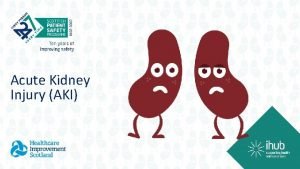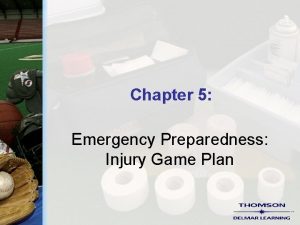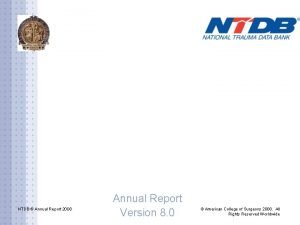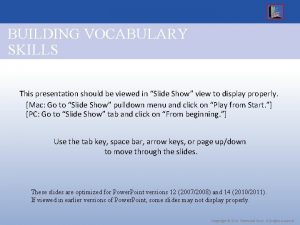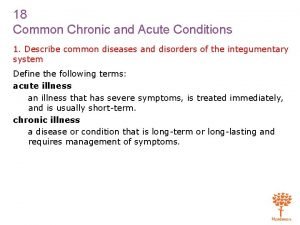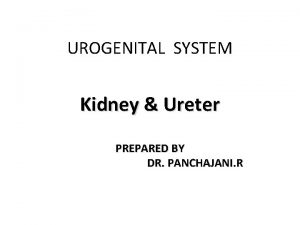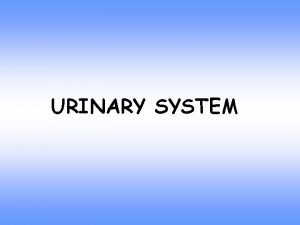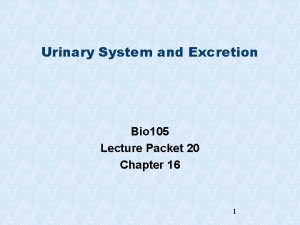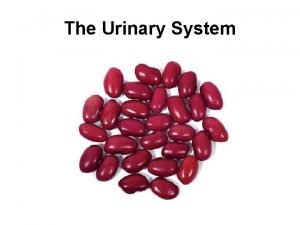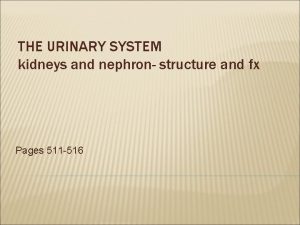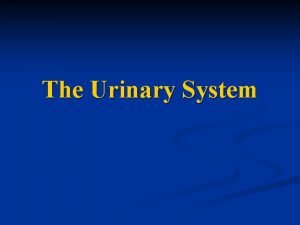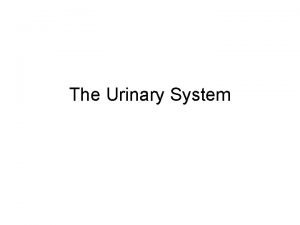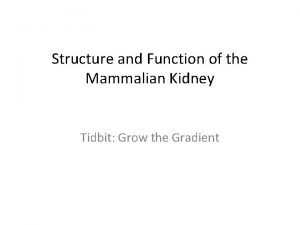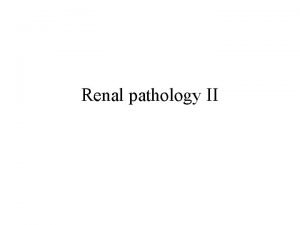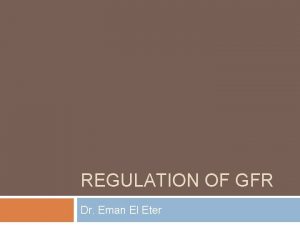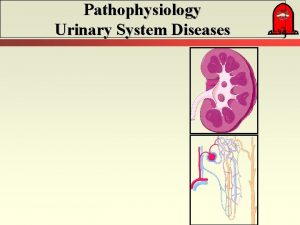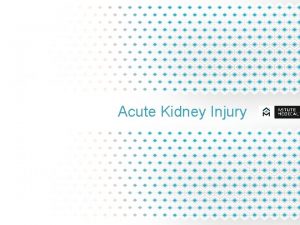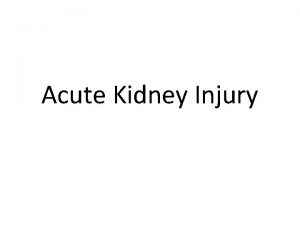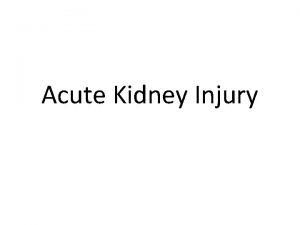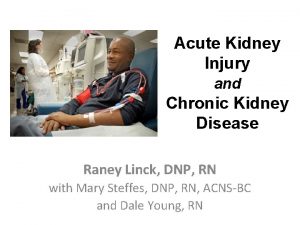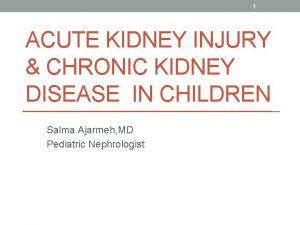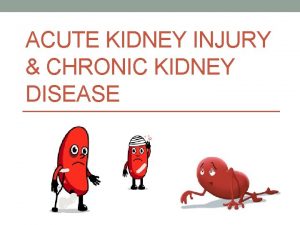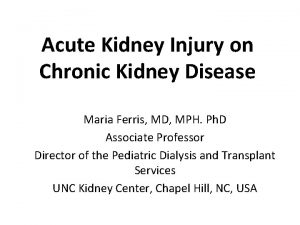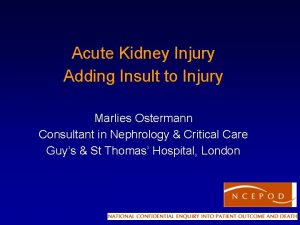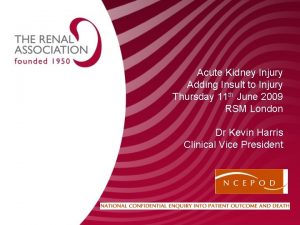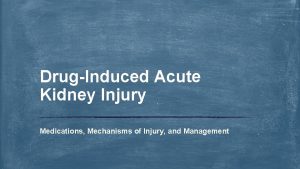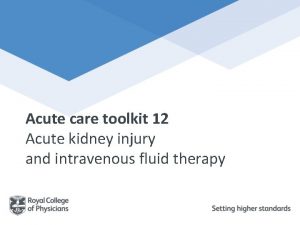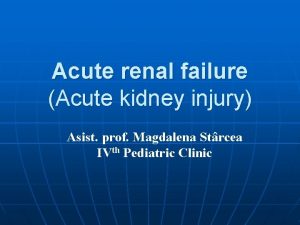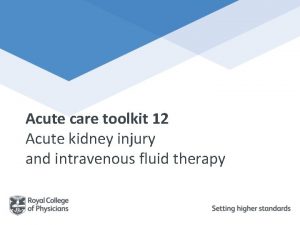Chapter 5 Acute Kidney Injury 2014 ANNUAL DATA




















- Slides: 20

Chapter 5: Acute Kidney Injury 2014 ANNUAL DATA REPORT VOLUME 1: CHRONIC KIDNEY DISEASE

vol 1 Figure 1. 1 Percent of Medicare patients aged 66+, (a) with at least one AKI hospitalization, and (b) with an AKI hospitalization that had dialysis by year, 20032012 (a) Data Source: Medicare 5 percent sample. 5. 1 a: Percent with an AKI hospitalization among all Medicare patients aged 66 and older who had both Medicare Parts A & B, no Medicare Advantage plan (Part C/HMO), no ESRD by first service date from Medical Evidence form, and were alive on January 1 of year shown. 5. 1 b: Percent of patients receiving dialysis during their first AKI hospitalization among patients with a first AKI hospitalization. Dialysis is identified by a diagnosis or charge for dialysis on the AKI hospitalization inpatient claim or a physician/supplier (Part B) claim for dialysis during the time period of the AKI inpatient claim. Abbreviation: AKI, acute kidney injury. Vol 1, CKD, Ch 5 2

vol 1 Figure 1. 1 Percent of Medicare patients aged 66+, (a) with at least one AKI hospitalization, and (b) with an AKI hospitalization that had dialysis by year, 20032012 (b) Data Source: Medicare 5 percent sample. 5. 1 a: Percent with an AKI hospitalization among all Medicare patients aged 66 and older who had both Medicare Parts A & B, no Medicare Advantage plan (Part C/HMO), no ESRD by first service date from Medical Evidence form, and were alive on January 1 of year shown. 5. 1 b: Percent of patients receiving dialysis during their first AKI hospitalization among patients with a first AKI hospitalization. Dialysis is identified by a diagnosis or charge for dialysis on the AKI hospitalization inpatient claim or a physician/supplier (Part B) claim for dialysis during the time period of the AKI inpatient claim. Abbreviation: AKI, acute kidney injury. Vol 1, CKD, Ch 5 3

vol 1 Table 5. 1 Characteristics of Medicare patients aged 66+ with at least one AKI hospitalization: age, sex, race, CKD, DM by year, 2003 -2012 2003 2004 2005 2006 2007 2008 2009 2010 2011 2012 66 -69 10. 6 10. 5 10. 3 10. 6 10. 3 10. 9 10. 8 11. 3 70 -74 16. 5 16. 3 16. 0 15. 3 15. 4 15. 5 15. 4 15. 6 15. 8 75 -79 21. 8 21. 3 21. 0 20. 2 19. 4 18. 5 18. 6 18. 0 17. 7 18. 0 80 -84 22. 5 22. 9 22. 3 22. 4 21. 5 21. 3 20. 7 19. 9 85+ 28. 6 29. 0 29. 9 31. 6 32. 1 33. 4 33. 7 34. 3 34. 7 34. 9 Female 47. 9 48. 0 47. 7 48. 1 47. 8 47. 5 47. 7 48. 2 Male 52. 1 52. 0 52. 3 51. 9 52. 2 52. 5 52. 3 51. 9 White 82. 9 82. 6 81. 7 82. 0 82. 8 83. 2 83. 1 82. 7 Black/African American 12. 7 13. 0 13. 7 13. 5 12. 0 12. 1 12. 0 12. 2 Native Am 0. 4 0. 3 0. 4 0. 5 Asian 1. 0 1. 3 1. 2 1. 4 1. 5 Other 3. 0 2. 9 3. 1 2. 9 3. 0 2. 9 3. 1 No DM or CKD prior year 55. 0 53. 3 52. 2 51. 2 49. 4 48. 2 47. 2 46. 0 44. 5 43. 4 DM no CKD prior year 24. 6 25. 2 25. 1 23. 0 22. 5 22. 0 21. 1 CKD no DM prior year 8. 8 9. 5 10. 0 12. 1 12. 8 13. 5 13. 9 14. 8 15. 3 11. 7 12. 0 13. 2 13. 7 15. 4 16. 0 16. 8 17. 7 18. 7 20. 2 Age Sex Race Pre-existing comorbidities Both CKD & DM prior year Data Source: Medicare 5 percent sample. Medicare patients aged 66 and older who had both Medicare Parts A & B, no Medicare Advantage plan (Part C/HMO), no ESRD by first service date from Medical Evidence form, and were alive on January 1 of year shown. Abbreviations: AKI, acute kidney injury; CKD, chronic kidney disease; DM, diabetes mellitus. Vol 1, CKD, Ch 5 4

vol 1 Figure 5. 2 Unadjusted rates of first hospitalization with AKI for Medicare patients aged 66+ by age and year, 2003 -2012 Data Source: Medicare 5 percent sample. Age as of January 1 of specified year. All patient-years at risk for Medicare patients aged 66 and older who had both Medicare Parts A & B, no Medicare Advantage plan (Part C/HMO), no ESRD by first service date from Medical Evidence form, and were alive on January 1 of year shown. Censored at death, ESRD, end of Medicare Parts A & B participation, or switch to Medicare Advantage program. Abbreviation: AKI, acute kidney injury. Vol 1, CKD, Ch 5 5

vol 1 Figure 5. 3 Unadjusted rates of first hospitalization with AKI for Medicare patients aged 66+ by race and year, 2003 -2012 Data Source: Medicare 5 percent sample. All patient-years at risk for Medicare patients aged 66 or older who had both Medicare Parts A & B, no Medicare Advantage plan (Part C/HMO), no ESRD by first service date from Medical Evidence form, and were alive on January 1 of year shown. Censored at death, ESRD, end of Medicare Parts A & B participation, or switch to Medicare Advantage program. Abbreviations: Af Am, African American; AKI, acute kidney injury. Vol 1, CKD, Ch 5 6

vol 1 Figure 5. 4 Unadjusted rates of first hospitalization with AKI for Medicare patients aged 66+ by CKD, DM and year, 2003 -2012 Data Source: Medicare 5 percent sample. All patient-years at risk for Medicare patients aged 66 and older who had both Medicare Parts A & B, no Medicare Advantage plan (Part C/HMO), no ESRD by first service date from Medical Evidence form, and were alive on January 1 of year shown. Censored at death, ESRD, end of Medicare Parts A & B participation, or switch to Medicare Advantage program. Abbreviations: AKI, acute kidney injury; CKD, chronic kidney disease; DM, diabetes mellitus. Vol 1, CKD, Ch 5 7

vol 1 Figure 5. 5 Adjusted hazard of a first AKI hospitalization in Medicare patients aged 66+, overall and dialysis-requiring, by age, 2012 Data Source: Medicare 5 percent sample. Medicare patients aged 66 or older who had both Medicare Parts A & B, no Medicare Advantage plan (Part C/HMO), no ESRD by first service date from Medical Evidence form, and were alive on 1/1/2012. Dialysis is identified by a diagnosis or charge for dialysis on the AKI inpatient claim or a physician/supplier (Part B) claim for dialysis during the time period of the AKI inpatient claim. Models each include age, race, sex, DM, and CKD status in prior year. Censored at death, ESRD, end of Medicare Parts A & B participation, or switch to Medicare Advantage program. Error bars represent 95% confidence interval of estimates. Abbreviation: AKI, acute kidneyinjury. Vol 1, CKD, Ch 5 8

vol 1 Figure 5. 6 Adjusted hazard of an AKI hospitalization in Medicare patients by DM & CKD status, 2012 Data Source: Medicare 5 percent sample. Medicare patients aged 66 and older who had both Medicare Parts A & B, no Medicare Advantage plan (Part C/HMO), no ESRD by first service date from Medical Evidence form, and were alive on 1/1/2012. Dialysis is identified by a diagnosis or charge for dialysis on the AKI inpatient claim or a physician/supplier (Part B) claim for dialysis during the time period of the AKI inpatient claim. Models each include age, race, sex, DM, and CKD status in prior year. Censored at death, ESRD, end of Medicare Parts A & B participation, or switch to Medicare Advantage program. Error bars represent 95% confidence interval of estimates. Abbreviations: AKI, acute kidney injury; CKD, chronic kidney disease; DM, diabetes mellitus. Vol 1, CKD, Ch 5 9

vol 1 Figure 5. 7 Cumulative probability of a recurrent AKI hospitalization within two years of live discharge from first AKI hospitalization in 2010 for Medicare patients aged 66+, (a) overall, (b) by age, (c) by race, and (d) by CKD and DM (a) Data Source: Medicare 5 percent sample. Age on January 1, 2010. Medicare patients aged 66 and older who had both Medicare Parts A & B, no Medicare Advantage plan (Part C/HMO), no ESRD by first service date from Medical Evidence form on 1/1/2010 and were discharged alive from an AKI hospitalization in 2010. Censored at death, ESRD, end of Medicare Parts A & B participation, or switch to Medicare Advantage program. Abbreviations: AKI, acute kidney injury; CKD, chronic kidney disease; DM, diabetes mellitus. Vol 1, CKD, Ch 5 10

vol 1 Figure 5. 7 Cumulative probability of a recurrent AKI hospitalization within two years of live discharge from first AKI hospitalization in 2010 for Medicare patients aged 66+, (a) overall, (b) by age, (c) by race, and (d) by CKD and DM (b) Data Source: Medicare 5 percent sample. Age on January 1, 2010. Medicare patients aged 66 and older who had both Medicare Parts A & B, no Medicare Advantage plan (Part C/HMO), no ESRD by first service date from Medical Evidence form on 1/1/2010 and were discharged alive from an AKI hospitalization in 2010. Censored at death, ESRD, end of Medicare Parts A & B participation, or switch to Medicare Advantage program. Abbreviations: AKI, acute kidney injury; CKD, chronic kidney disease; DM, diabetes mellitus. Vol 1, CKD, Ch 5 11

vol 1 Figure 5. 7 Cumulative probability of a recurrent AKI hospitalization within two years of live discharge from first AKI hospitalization in 2010 for Medicare patients aged 66+, (a) overall, (b) by age, (c) by race, and (d) by CKD and DM (c) Data Source: Medicare 5 percent sample. Age on January 1, 2010. Medicare patients aged 66 and older who had both Medicare Parts A & B, no Medicare Advantage plan (Part C/HMO), no ESRD by first service date from Medical Evidence form on 1/1/2010 and were discharged alive from an AKI hospitalization in 2010. Censored at death, ESRD, end of Medicare Parts A & B participation, or switch to Medicare Advantage program. Abbreviations: AKI, acute kidney injury; CKD, chronic kidney disease; DM, diabetes mellitus. Vol 1, CKD, Ch 5 12

vol 1 Figure 5. 7 Cumulative probability of a recurrent AKI hospitalization within two years of live discharge from first AKI hospitalization in 2010 for Medicare patients aged 66+, (a) overall, (b) by age, (c) by race, and (d) by CKD and DM (d) Data Source: Medicare 5 percent sample. Age on January 1, 2010. Medicare patients aged 66 and older who had both Medicare Parts A & B, no Medicare Advantage plan (Part C/HMO), no ESRD by first service date from Medical Evidence form on 1/1/2010 and were discharged alive from an AKI hospitalization in 2010. Censored at death, ESRD, end of Medicare Parts A & B participation, or switch to Medicare Advantage program. Abbreviations: AKI, acute kidney injury; CKD, chronic kidney disease; DM, diabetes mellitus. Vol 1, CKD, Ch 5 13

vol 1 Figure 5. 8 Cumulative probability of death-censored ESRD, death, and the composite of death or ESRD within one year of live discharge from first AKI hospitalization occurring in 2010 -2011 for Medicare patients aged 66+ Data Source: Medicare 5 percent sample. Medicare patients aged 66 or older who had both Medicare Parts A & B, no Medicare Advantage plan (Part C/HMO), no ESRD by first service date from Medical Evidence form, and were discharged alive from a first AKI hospitalization in 2010 or 2011. All models censored at the end of Medicare Parts A & B participation, switch to Medicare Advantage program, or 365 days after AKI discharge. Model for ESRD also is censored at death. Model for death is not censored at the start of ESRD. Abbreviations: AKI, acute kidney injury by diagnosis code; ESRD, end-stage renal disease. Vol 1, CKD, Ch 5 14

vol 1 Figure 5. 9 Outpatient physician visits within one year of live discharge from first AKI hospitalization in 2011 for Medicare patients aged 66+ by physician specialty and time Data Source: Medicare 5 percent sample. Medicare patients aged 66 and older who had both Medicare Parts A & B, no Medicare Advantage plan (Part C/HMO), no ESRD by first service date from Medical Evidence form on 1/1/2011, and were discharged alive from a first AKI hospitalization in 2011. For each time point, the denominator is all patients alive, without ESRD, not in a Medicare Advantage plan and with Medicare Parts A & B. Physician visits are from physician/supplier claims with provider specialty codes for primary care (01, 08 -family practice, 11 -internal medicine), cardiology (06), and nephrology (39) and claim source indicating an outpatient setting. Abbreviation: AKI, acute kidney injury. Vol 1, CKD, Ch 5 15

vol 1 Figure 5. 10 Outpatient nephrology visits within one year of live discharge from first AKI hospitalization in 2011 for Medicare patients aged 66+ by CKD, DM, and time Data Source: Medicare 5 percent sample. Medicare patients aged 66 and older who had both Medicare Parts A & B, no Medicare Advantage plan (Part C/HMO), no ESRD by first service date from Medical Evidence form on 1/1/2011, and were discharged alive from a first AKI hospitalization in 2011. For each time point, the denominator is all patients alive, without ESRD, not in a Medicare Advantage plan and with Medicare Parts A & B. Physician visits are from physician/supplier claims with provider specialty codes for nephrology (39) and claim source indicating an outpatient setting. Abbreviations: AKI, acute kidney injury; CKD, chronic kidney disease; DM, diabetes mellitus. Vol 1, CKD, Ch 5 16

vol 1 Figure 5. 11 Cumulative probability of a claim for a serum creatinine test within one year of live discharge from first AKI hospitalization in 2011 for Medicare patients aged 66+ by CKD, DM and time Data Source: Medicare 5 percent sample. Medicare patients aged 66 and older who had both Medicare Parts A & B, no Medicare Advantage plan (Part C/HMO), no ESRD by first service date from Medical Evidence form on 1/1/2011, and were discharged alive from a first AKI hospitalization in 2011. Date of first serum creatinine test following AKI discharge is from inpatient and outpatient claims with healthcare common procedure coding system (HCPCS) codes of 80048, 80050, 80053, 80069, or 82565. Censored at death, ESRD, end of Medicare Parts A & B participation, or switch to Medicare Advantage program. Abbreviations: AKI, acute kidney injury; CKD, chronic kidney disease; DM, diabetes mellitus. Vol 1, CKD, Ch 5 17

vol 1 Figure 5. 12 Cumulative probability of a claim for an urine albumin test within one year of live discharge from first AKI hospitalization in 2011 for Medicare patients aged 66+ by CKD, DM and time Data Source: Medicare 5 percent sample. Medicare patients aged 66 and older who had both Medicare Parts A and B, no Medicare Advantage plan (Part C/HMO), no ESRD by first service date from Medical Evidence form on 1/1/2011, and were discharged alive from a first AKI hospitalization in 2011. Date of first urine albumin test following AKI discharge is from inpatient and outpatient claims with healthcare common procedure coding system (HCPCS) codes of 82042, 82043, 82044, or 84156. Censored at death, ESRD, end of Medicare Parts A & B participation, or switch to Medicare Advantage program. Abbreviations: AKI, acute kidney injury; CKD, chronic kidney disease; DM, diabetes mellitus. Vol 1, CKD, Ch 5 18

vol 1 Figure 5. 13 Renal status one year following discharge from AKI hospitalization in 2010 -2011, among surviving Medicare patients aged 66+ without kidney disease prior to AKI hospitalization, by CKD stage and ESRD status Data Source: Medicare 5 percent sample. Medicare patients aged 66 and older who had both Medicare Parts A & B, no Medicare Advantage plan (Part C/HMO), did not have ESRD, were discharged alive from a first AKI hospitalization in 2010 or 2011, and did not have any claims with a diagnosis of CKD in the 365 days prior to the AKI. Renal status after AKI determined from claims between discharge from AKI hospitalization and 365 days after discharge. Stage determined by 585. x claim closest to 365 days after discharge; ESRD by first service date on Medical Evidence form. Abbreviations: AKI, acute kidney injury; CKD, chronic kidney disease. Vol 1, CKD, Ch 5 19

vol 1 Figure 5. 14 Hospital discharge status of first AKI hospitalization for Medicare patients aged 66+, 2012 Data Source: Medicare 5 percent sample. Medicare patients aged 66 or older who had both Medicare Parts A & B, no Medicare Advantage plan (Part C/HMO), did not have ESRD on 1/1/2012 and had a first AKI hospitalization in 2012. Institution includes short-term skilled nursing facilities, rehabilitation hospitals, and long-term care facilities. Home also includes patients receiving home health care services. Excludes patients admitted to the acute care hospital from a skilled nursing facility. Abbreviation: AKI, acute kidney injury. Vol 1, CKD, Ch 5 20
 Acute kidney injury
Acute kidney injury Intentional and unintentional injury
Intentional and unintentional injury Chapter 5 emergency preparedness injury game plan
Chapter 5 emergency preparedness injury game plan Chapter 25 suicide and nonsuicidal self injury
Chapter 25 suicide and nonsuicidal self injury National trauma data bank annual report 2020
National trauma data bank annual report 2020 Sentence check 2 chapter 10
Sentence check 2 chapter 10 Chapter 18 common chronic and acute conditions
Chapter 18 common chronic and acute conditions Hoarse shoe kidney
Hoarse shoe kidney Juxtaglomerular apparatus
Juxtaglomerular apparatus Pearson
Pearson Kidney infection
Kidney infection Interpolar region of kidney
Interpolar region of kidney Nephron structure
Nephron structure Function of macula densa
Function of macula densa Figure 15-3 is a diagram of the nephron
Figure 15-3 is a diagram of the nephron Medulla kidney
Medulla kidney Slk medical abbreviation transplant
Slk medical abbreviation transplant Pathology
Pathology Tubuloglomerular feedback mechanism
Tubuloglomerular feedback mechanism Histological structure of kidney
Histological structure of kidney Coverings of kidney
Coverings of kidney
